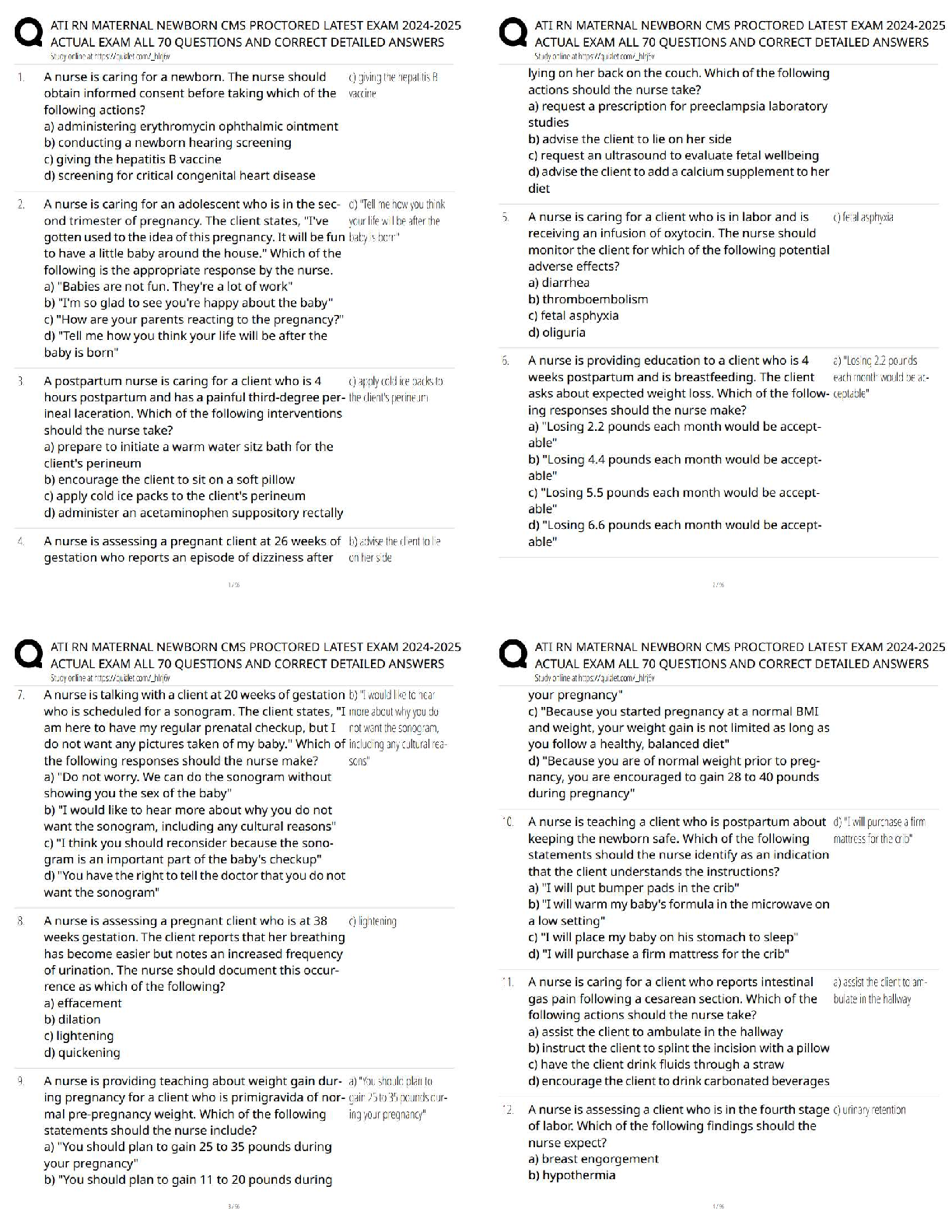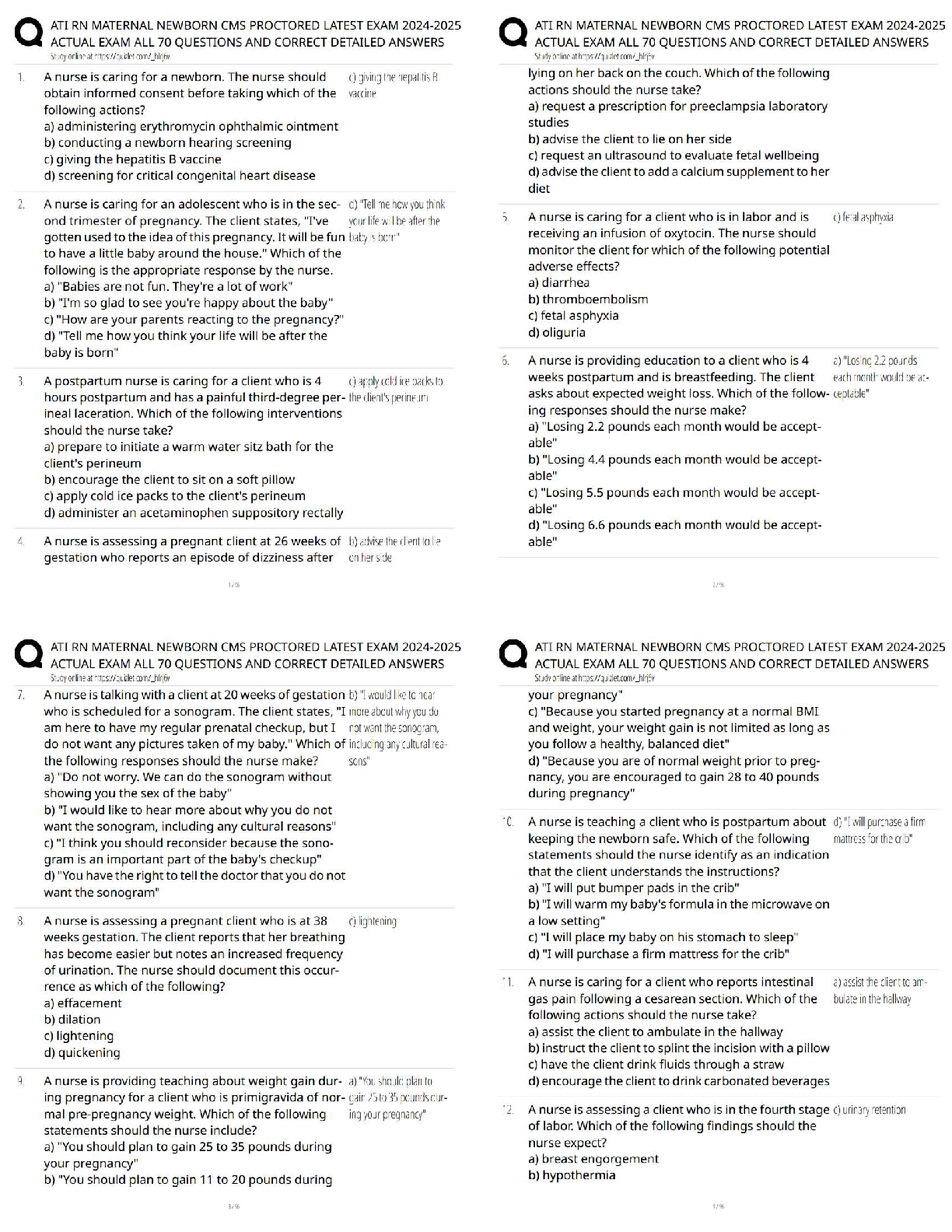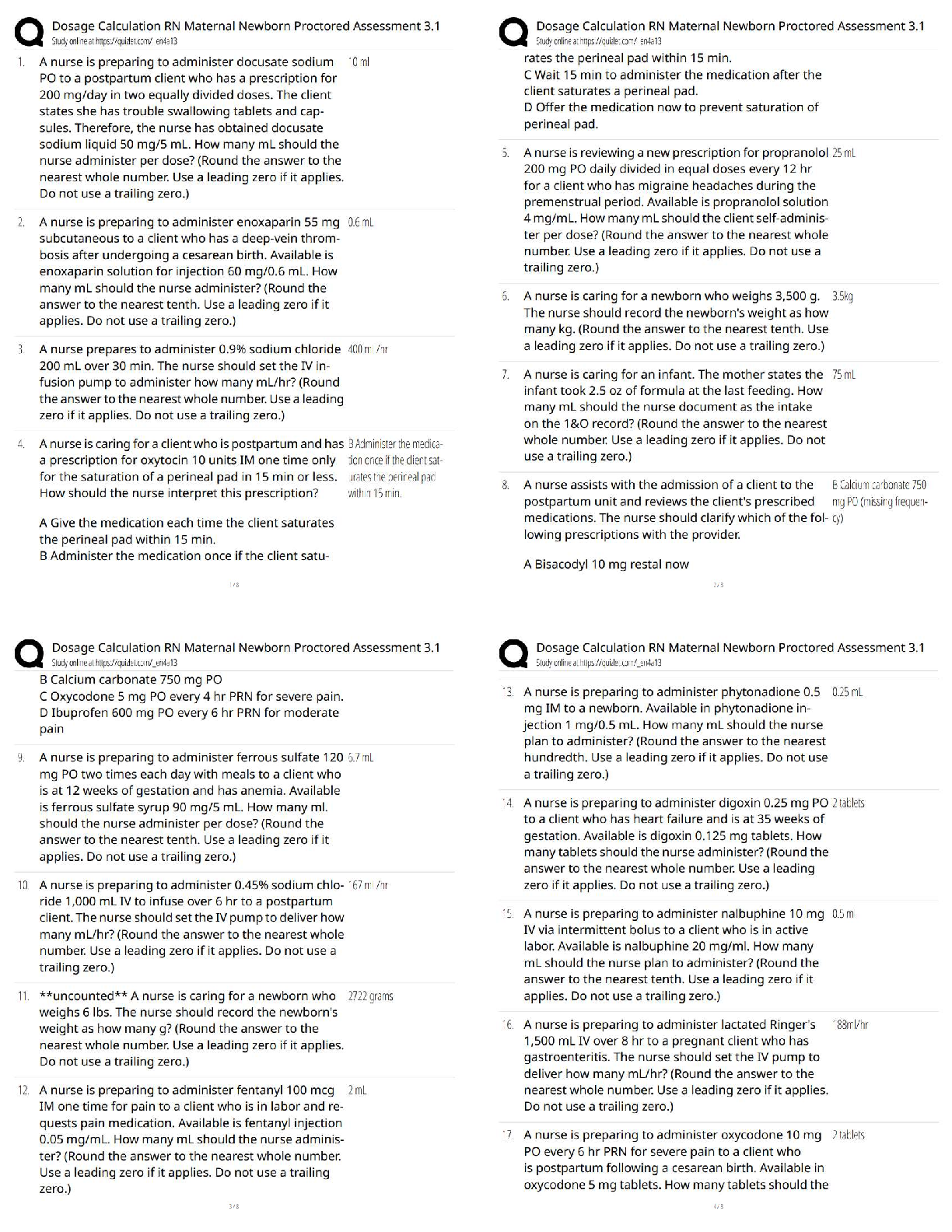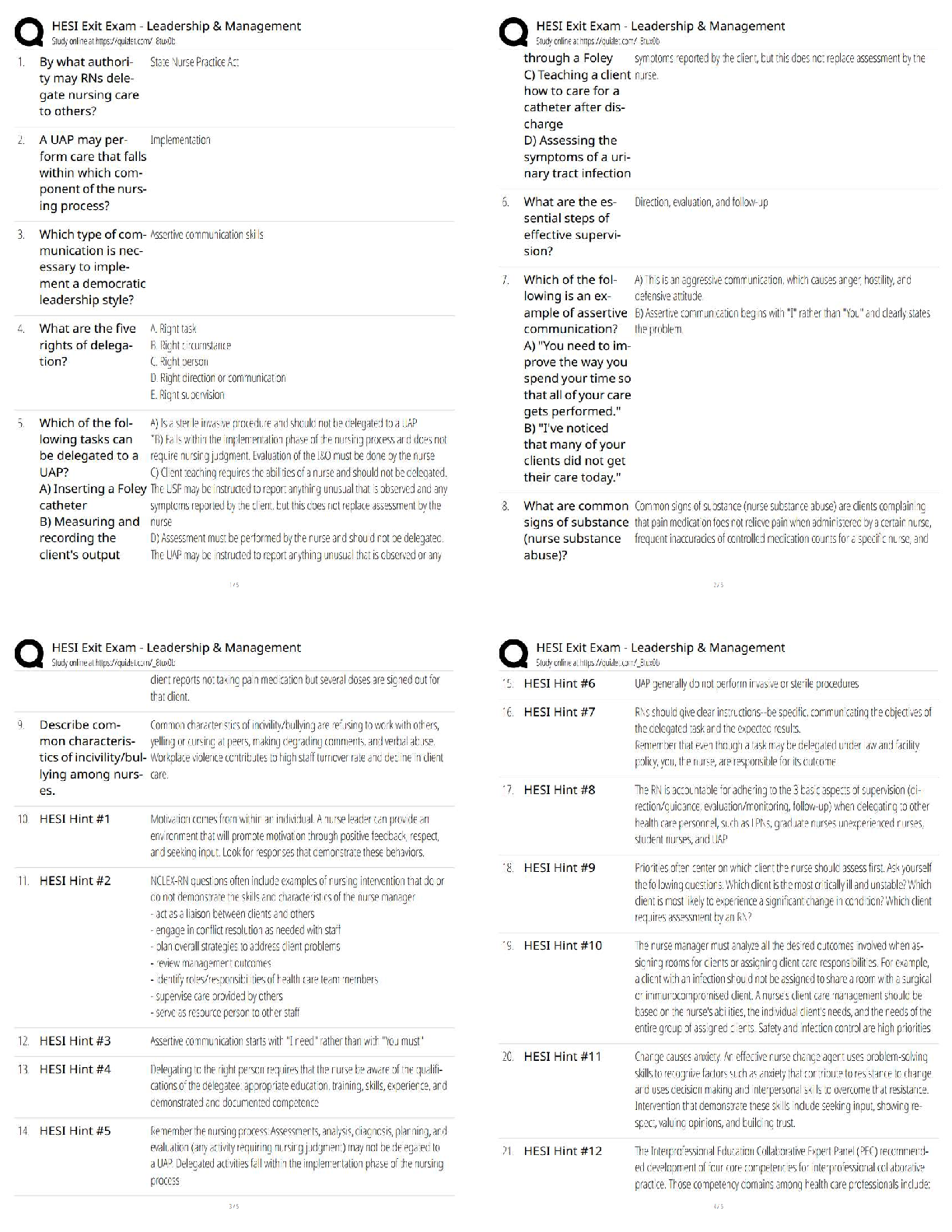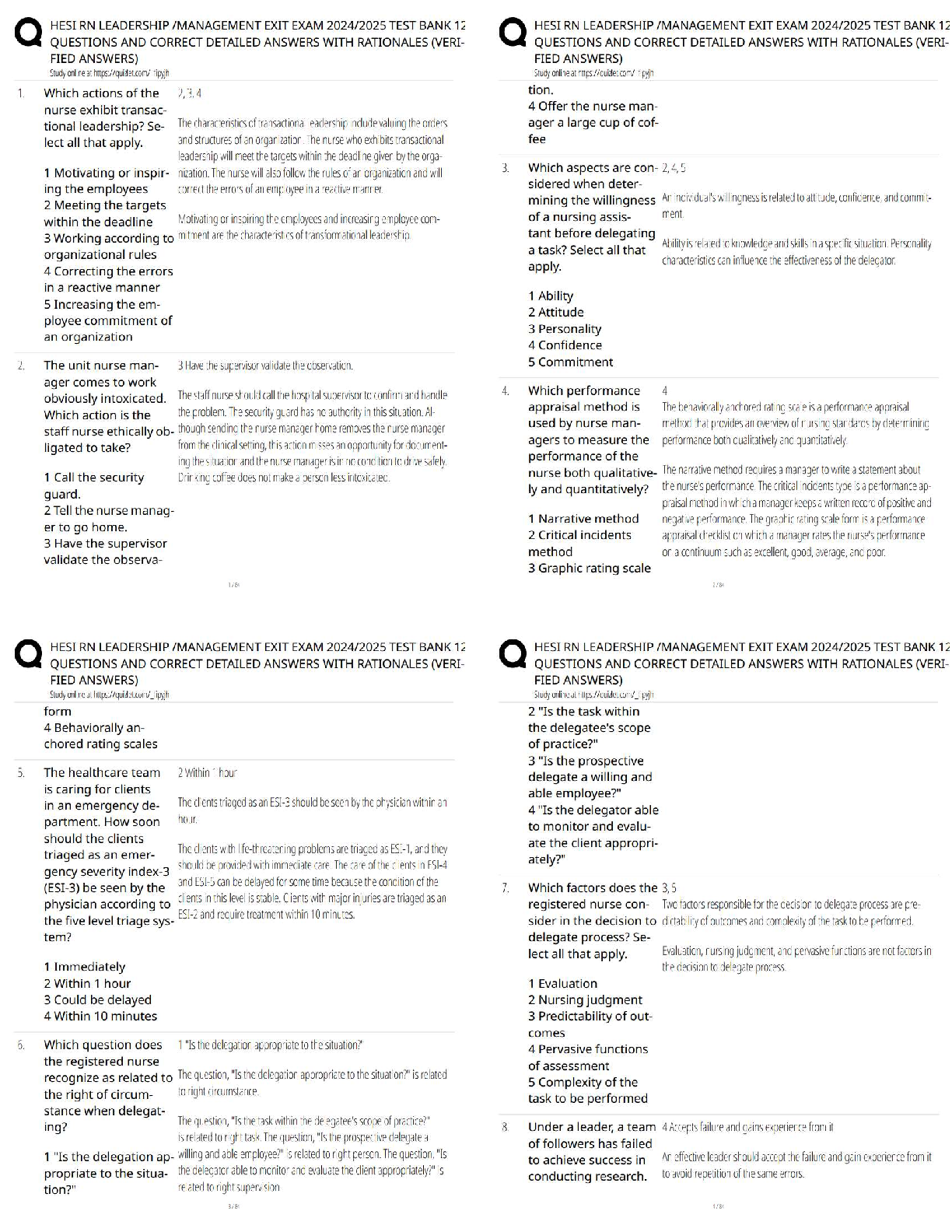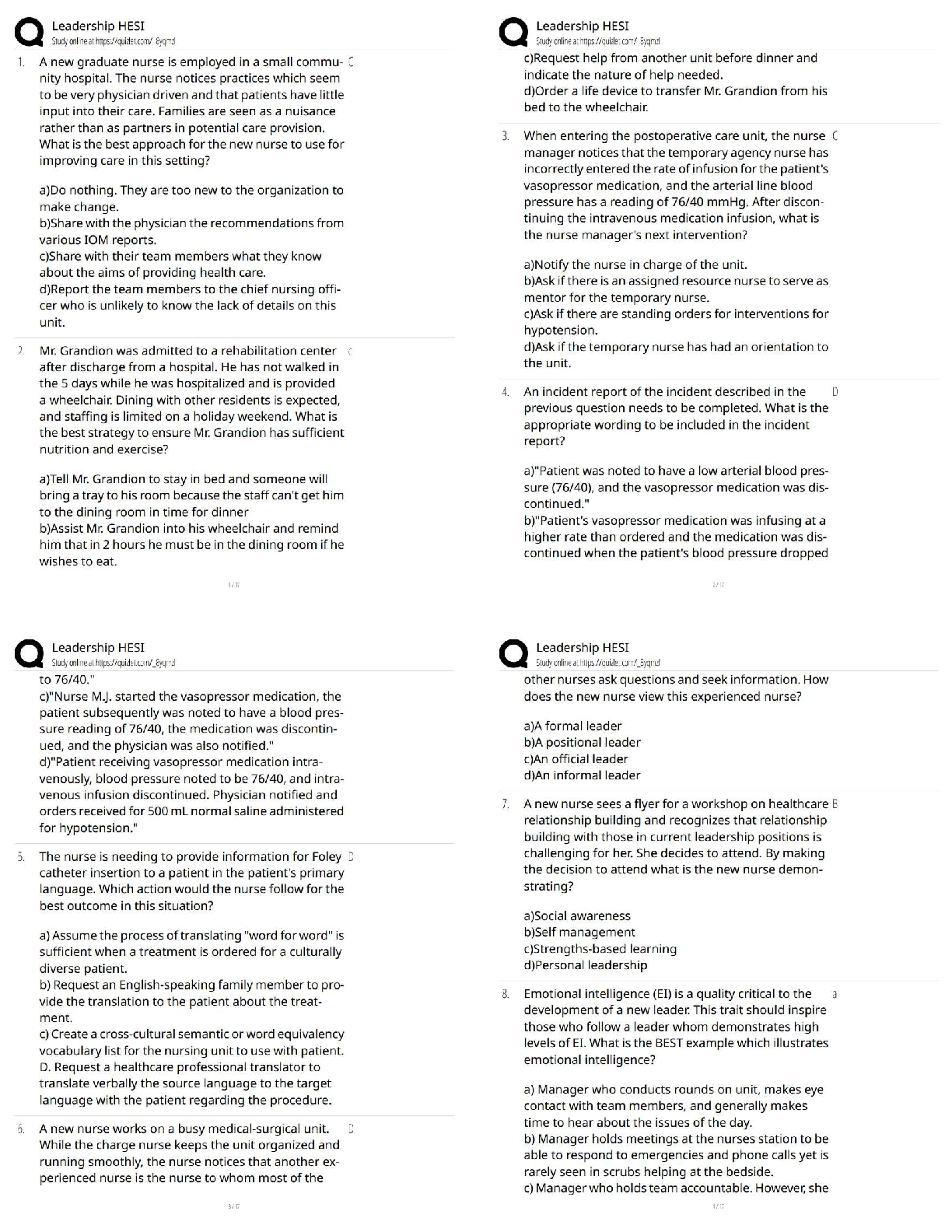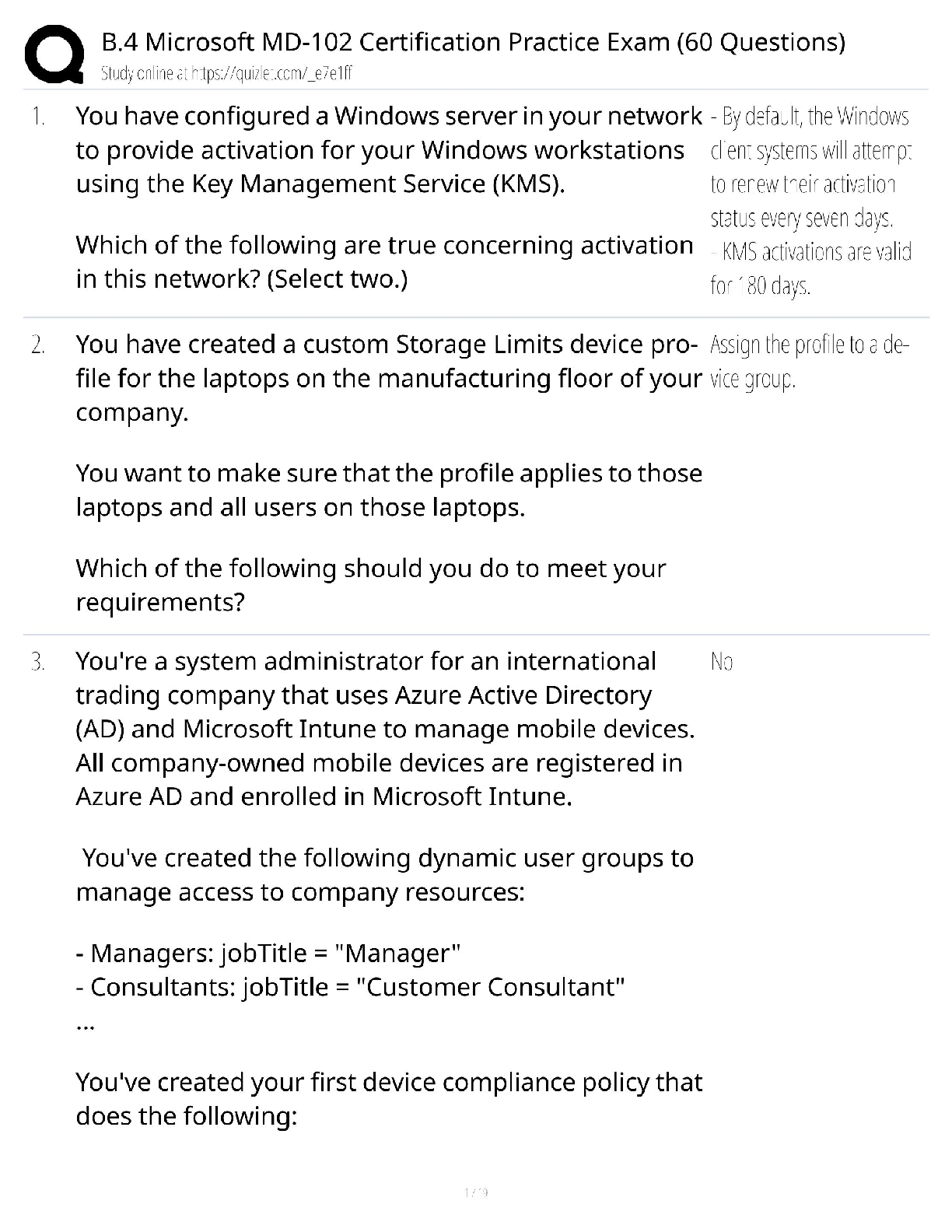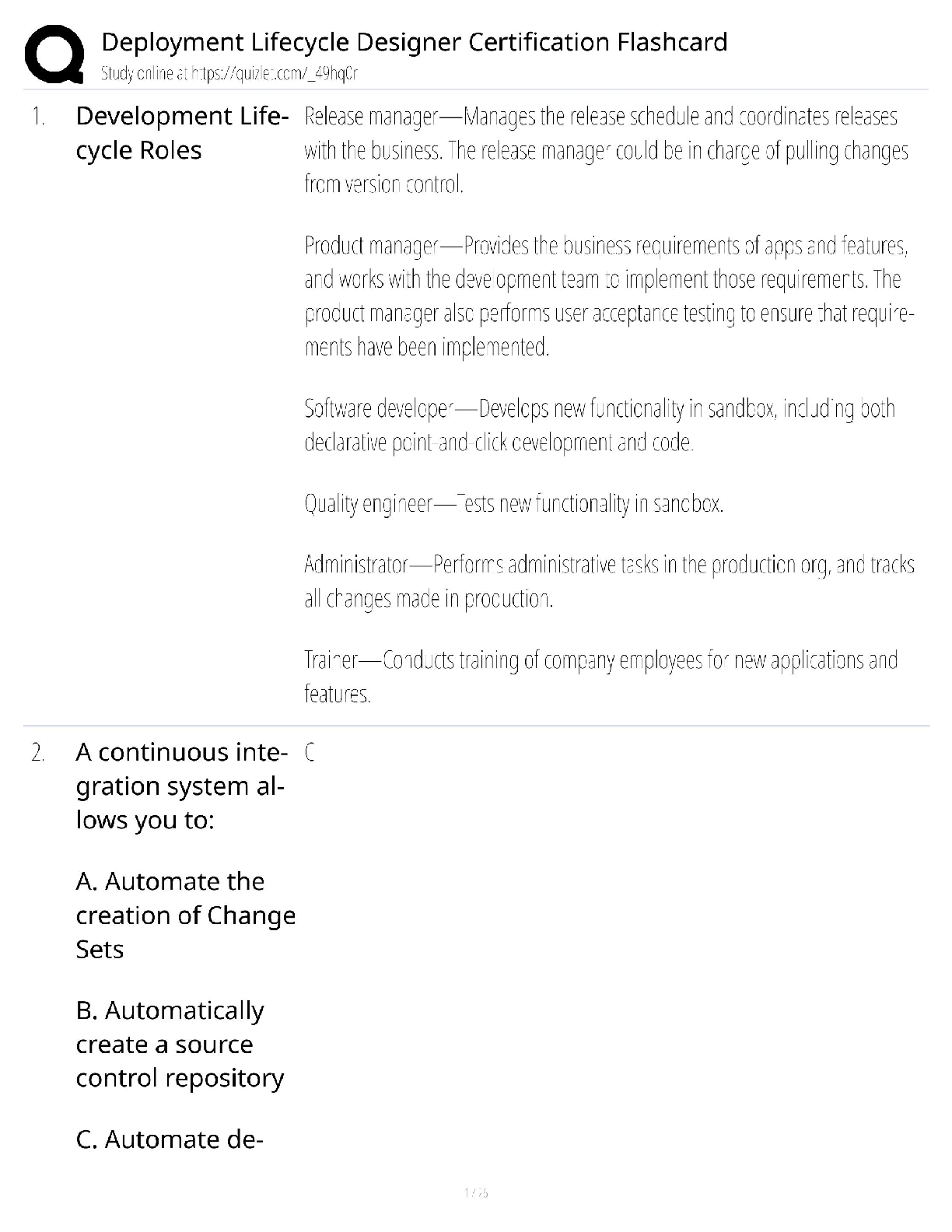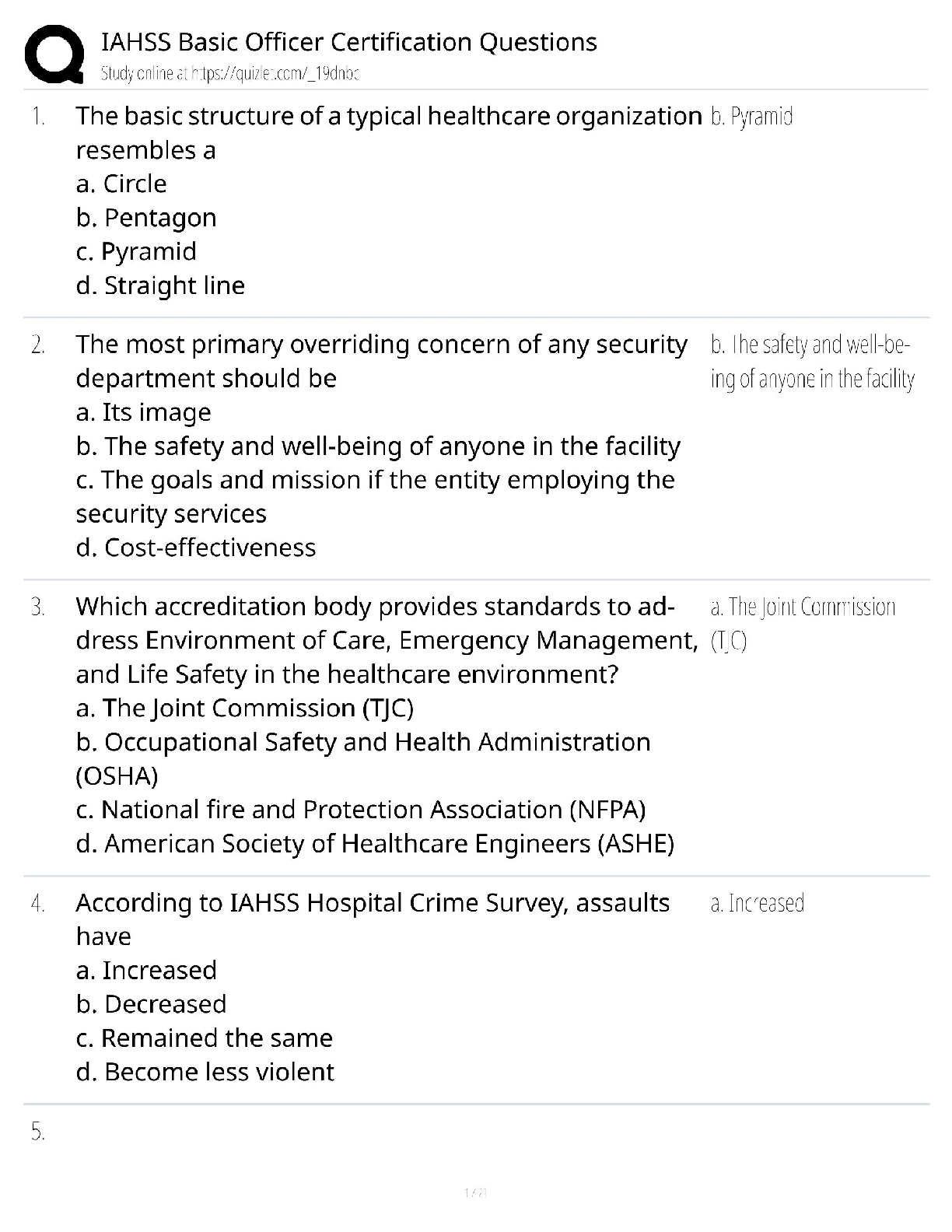Biology > QUESTIONS & ANSWERS > AP Biology Sem 1_ 4.1.1 Read: Cell Reproduction Reading Guide | Reading Assignment: Principles of Li (All)
AP Biology Sem 1_ 4.1.1 Read: Cell Reproduction Reading Guide | Reading Assignment: Principles of Life (2nd edition) (Questions AND Answers)
Document Content and Description Below
4.1.1 Read: Cell Reproduction Reading Guide AP Biology Sem 1 (S3043799) Name: ____________________ Date: ____________ Reading Assignment: Principles of Life (2nd edition) Please ... read the following sections of your textbook. As you read, use this reading guide to check your understanding of the material. Part Reading Assignment I Chapter 7 The Cell Cycle and Cell Division (7.1, 7.2, 7.3, 7.4, 7.5) II Chapter 3 Nucleic Acids, Proteins, and Enzymes (3.1) Chapter 8 Inheritance, Genes, and Chromosomes (8.3, 8.4) Chapter 9 DNA and Its Role in Heredity (9.1, 9.2) Part I Describe the products of asexual reproduction. Compare haploid and diploid cells. Identify and describe the three steps of the cell cycle. In the space below, draw a chromosome with sister chromatids, a centromere, and kinetochores. Describe the function of the spindle. . In the space below, identify the phases of mitosis and draw a typical cell in each of the phases. Then describe the events that occur during each of the phases. Phase (Students' drawings should resemble those on pp. 130 - 131.) Events Prophase Prometaphase Metaphase Telophase Explain the structural differences between cytokinesis in animal cells and in plant cells. How do cells know when to enter the cell cycle to divide? In the space below, draw a picture of the eukaryotic cell cycle and label the subphases and checkpoint. Describe the function of a cyclin-dependent kinase. Describe how the function of meiosis differs from that of mitosis. In the space below, draw mitosis as compared to meiosis. Use different colors for different chromosomes and label each cell as haploid or diploid. Explain the mechanism of crossing over during prophase of meiosis I, and describe how it generates genetic variation. In the space below, draw a recombinant chromosome. What happens when something goes wrong in meiosis? In the space below, list the possible errors during meiosis, describe the events, and explain their consequences for offspring. Meiotic error Description Explanation of consequences Nondisjunction Polyploidy Translocation Explain the purpose of apoptosis. In the space below, draw a flow chart describing the events of apoptosis. Part II Describe the structure and function of a bacteriophage. Describe Chargaff’s rule. As an example, if we know that 20% of a given DNA molecule is composed of adenine, what are the other percentages? An important discovery in the study of DNA was that DNA is replicated semiconservatively. In the space below, draw a semiconservative round of replication using two different colors for the parental strands and the new strands. To which end are nucleotides added to the growing new strand during DNA replication? Why? How does the quantity of origins of replications differ in number in prokaryotes and eukaryotes? What would be the consequences to eukaryotes if they used the same number of origins? For each of the following structures or enzymes necessary for DNA replication to occur, describe the function. Structure/Enzyme Function Primer Primase DNA polymerase Leading strand Lagging strand Okazaki fragment DNA ligase Telomere Telomerase In the space below, draw a typical DNA replication fork and label the structures and enzymes listed above. Explain antiparallelism as it relates to DNA formation. Key Terms As you come across these terms during your reading, write your own definition in the space provided. Asexual reproduction Clone Mitosis Meiosis . Chromosome Chromatin Somatic cells Homologous pairs Haploid Diploid Zygote Fertilization Binary fission Segregation Cell cycle Interphase Prophase Sister chromatids Centromere Kinetochores Karyotype Centrosome Centriole Spindle apparatus Daughter cell Growth factors Cyclin dependent kinases (Cdks) Checkpoint Condensation Crossing over Tetrad equatorial (metaphase) plate Recombinant Independent assortment Nondisjunction Polyploidy Aneuploid Translocation Apoptosis Caspases Oncogene Tumor suppressor gene Bacteriophage Transformation Purine Pyrimidine Semiconservative replication Template strand Deoxyribonucleoside triphosphate (dNTPs) DNA polymerase Origin of replication Replication fork Primer Primase Topoisomerase Leading strand Lagging strand Okazaki fragment DNA ligase Telomere Telomerase 4.1.3 Study: Modeling DNA Replication Study Sheet AP Biology Sem 1 (S3043799) Name: ____________________ Date: ____________ 1. Several enzymes participate in DNA replication. In the column on the left, write the correct enzyme type next to each description. Enzyme types: DNA polymerase, helicase, ligase, topoisomerase Replication Enzymes Type of enzyme Description Opens DNA double helix Clips and unwinds DNA Adds nucleotides and corrects errors Seals DNA strands together along its length 2. In what way is inference related to direct observation? 3. In what way does the coiling of DNA as a helix affect the position of its 3' and 5' ends? . 4. What is semiconservative replication in DNA? 5. In the area below, draw a simple representation of a DNA replication fork with Okazaki fragments. Label the Okazaki fragments, the leading and lagging strands, and the 5' and 3' ends. Use arrows to show the direction of replication. 4.1.5 Study: Cell Cycle Checkpoints and Cancer Study Sheet AP Biology Sem 1 (S3043799) Name: ____________________ Date: ____________ As you read through the study, use this study sheet to help you organize your thoughts and collect data. Record the events that occur during each phase or checkpoint of the cell cycle. Phase or checkpoint Events/Requirements G1 phase G1 checkpoint S phase G2 phase G2 checkpoint First portion of M phase M-spindle checkpoint Second portion of M phase through cytokinesis In the area below, identify the error for each of the following cells. Cell β Cell θ Cell Ψ Cell For each of the following processes, explain how nondisjunction can cause varying consequences to the individual and offspring. Process Consequence 4.1.7 Practice: Cell Reproduction Practice Assignment AP Biology Sem 1 (S3043799) Name: ____________________ Points possible: 25 Date: ____________ 1. During human embryonic development, many neurons arise and form connections with one another. However, much later these same neurons are found to be absent. Describe the process that accounts for this loss of early neurons, and explain how this process achieves the changes described. (5 points) 2. The transmission of genetic information from parent to daughter cells is highly accurate. Describe the features of DNA replication responsible for this fidelity of information transfer. Explain why this mechanism allows the high level of accuracy of information transfer that is observed. (5 points) 3. DNA is the primary source of heritable information in cells. Explain how the chemical structure of DNA makes this possible. (5 points) 4. Compare and contrast the processes of sexual reproduction in eukaryotes and conjugation in bacteria in terms of how they contribute to genetic variation in a population. (5 points) 5. A population of the species Polymita picta is shown in the image below. Explain two mechanisms that could have contributed to the variations apparent in this population.(5 points) 4.1.9 Discuss: Meiosis and Mitosis Discussion AP Biology Sem 1 (S3043799) Name: ____________________ Points possible: 15 Date: ____________ This worksheet will help you organize your thoughts for the discussion. Answer the questions and prompts below to help you prepare for the discussion. 1. Predict the consequences to sexual reproduction if meiosis did not occur and all cells divided mitotically. Discuss chromosome number, variation, and the implications of these changes on the success of sexual reproduction. (5 points) 2. Chemotherapy drugs target specific cells in our body. However, there are also side effects to other body cells during chemotherapy. Explain why these drugs are effective against cancerous cells. What do you think are the dangers of chemotherapy drugs? Identify other types of cells that are likely to be quick to divide and therefore to be impacted by chemotherapy drugs. (5 points) 3. Summarize what you learned about the environmental effects on mitosis in your investigations. Which factors had the largest impact? What data support that conclusion? Were those data statistically significant? (5 points) 4.2.1 Read: Genetics and Gene Expression Reading Guide AP Biology Sem 1 (S3043799) Name: ____________________ Date: ____________ Reading Assignment: Principles of Life (2nd edition) Please read the following sections of your textbook. As you read, use this reading guide to check your understanding of the material. Part Reading Assignment I Chapter 8 Inheritance, Genes, and Chromosomes (8.1 – 8.4) II Chapter 11 Regulation of Gene Expression (11.1 – 11.4) III Chapter 12 Genomes (12.3) IV Chapter 14 Genes, Development, and Evolution (14.1, 14.3, 14.4) Part I Compare the following terms: How does a monohybrid cross illustrate Mendel’s law of segregation? How does a dihybrid cross illustrate Mendel’s law of independent assortment? What is the purpose of a testcross? How could you determine that genes are linked? What is the significance of a recombination frequency in terms of gene mapping? Describe the mechanism of recombination in prokaryotes. Part II Describe how gene expression can be positively regulated or negatively regulated. In the space below, draw the lac operon, labeling the promoters, operator, repressor, and structural genes. Explain the difference between an inducible operon and a repressible operon. Describe the TATA box. Compare DNA methylation and histone protein modification. Gene expression can also be modified after transcription. Describe the process of alternative splicing. Identify the three main ways that translation of eukaryotic mRNA can occur: Explain the main differences between eukaryotic and prokaryotic genomes. In the space below, define each type of stem cell and describe its location in the body. Type of stem cell Function Multipotent Pluripotent Explain pattern formation. Describe the function of organ identity genes. . Describe loss of function and gain of function mutations. Explain the function of hox genes. Describe the function of genetic switches. In the space below, draw an image that shows how hox regulatory genes have similar expression Explain how specific body structures, including wings, may have evolved by changes in how genes were expressed. Key Terms As you come across these terms during your reading, write your own definition in the space provided. Key Terms As you come across these terms in your reading, write your own definitions in the spaces provided. Parental generation First filial generation Second filial generation Dominant Recessive . Allele Homozygous . Heterozygous Phenotype Genotype Testcross Monohybrid cross Dihybrid cross Independent assortment Pedigree Wild type Mutation Codominance Incomplete dominance Hybrid vigor Genetic linkage Recombination frequency Hemizygous Sex-linked inheritance Transcription factor Operon Structural gene Epigenetic Histone Alternative splicing microRNA Bacterial conjugation Transposon Gene families . Single nucleotide polymorphisms (SNPs) Short tandem repeats (STRs) Organ identity genes Hox genes Homeobox Genetic switches Totipotent Plasmid 4.2.3 Study: Probability Demonstrations and Punnett Squares Study Sheet AP Biology Sem 1 (S3043799) Name: ____________________ Date: ____________ As you read through the study, use this study sheet to help you organize your thoughts. Distinguish between phenotype and genotype, and give an example of each. . In pea plants, smooth seeds are dominant to wrinkled seeds. If two pea plants that are heterozygous for the smoothness gene are crossed, what proportion of their offspring will have smooth seeds? Why do human X-linked recessive traits appear in the phenotypes of males more often than in the phenotypes of females? Inheritance patterns may follow simple Mendelian principles or may be more complex than predicted by simple Mendelian genetics. In the chart below, distinguish the inheritance patterns by writing Mendelian trait or Non-Mendelian trait in the column on the right. Draw lines matching the main ideas of this study with the four Big Ideas of AP Biology. For each main idea, explain how it is related to the Big Idea. 4.2.5 Study: Pedigree Analysis of Human Genetic Disorders Study Sheet AP Biology Sem 1 (S3043799) Name: ____________________ Date: ____________ 1. What is the initial question you are trying to answer? Question 2. Is there an initial prediction you can make about the question you've been asked? What information leads you to make that prediction? Write your prediction in the table below and explain the justifications for your prediction. Initial prediction Justification "I can make this prediction because..." 3. What questions do you have right now? What are you hoping the next section explains to you? 4. As you read through the study, record the evidence that you are given that could help you answer the question. 5. What conclusions did you draw at the end of the study? 6. Congratulations on solving the mystery!! As you look back on the case study, were there additional clues that you missed? If so, how would they have helped you to make your final prediction more accurate? 7. Are there additional clues that could have been provided that would have been helpful to you without giving away the answer to the questions? 4.2.7 Practice: Genetics and Gene Expression Practice Assignment AP Biology Sem 1 (S3043799) Name: ____________________ Points possible: 25 Date: ____________ 1. A woman buys seeds for an annual flowering plant. After planting the seeds in her garden, she is happy to see that all of them produce red flowers. She collects the seeds produced by the flowers at the end of the season and stores them over the winter. When she plants them the next spring, she is surprised to find that 8 plants produced white flowers and 32 plants produced red flowers. Explain this outcome by comparing the observed numbers of white and red flowering plants to those expected if the following conditions are assumed: • The plants are self-pollinating (that is, seeds are only produced by crosses between plants in the garden). • The flower color trait results from two alleles, one dominant and the other recessive. (3 points) 2. A human needs at least one functional allele for a particular protein in order to have normal metabolic behavior. A man and a woman marry and produce 8 children. Neither parent has the metabolic disorder related to the protein described above, but 3 of their children do. Explain the most likely pattern of inheritance, based on the data below. (3 points) Family Member Normal metabolism Metabolic disorder Father ✓ Mother ✓ Daughter 1 ✓ Daughter2 ✓ Son 1 ✓ Son 2 ✓ Son 3 ✓ Son 4 ✓ Son 5 ✓ Son 6 ✓ 3. The following table shows the results of a breeding experiment to study the inheritance of flower color and grain length in plants, two genes that exhibit complete dominance in phenotypes. True-breeding parent plants with purple flowers and long pollen grains were crossed with true-breeding parent plants with red flowers and short pollen grains. A second experiment was also conducted between members of the F1 generation to produce an F2 generation. The phenotypes of the resulting offspring in the F1 and F2 generations are in the figure below. a. Using the data in the table, identify the dominant alleles for flower color and grain length. Explain your response. (3 points) b. Analyze the distribution of phenotypes in the F2 generation. Explain whether the observed results match those expected based upon the results of the first cross. (3 points) 4. Wild fruit flies have a gray body, red eyes, and long wings. The three genes for these traits are all located on the same chromosome. Each gene has a normal, dominant allele and a mutant allele that gives rise to a different, recessive trait. The mutant traits are a black body (b), cinnabar eyes (cn), and vestigial wings (vg). The normal, dominant alleles are indicated with a plus-sign superscript — gray body (b+), red eyes (cn+), and long wings (vg+). The table below shows the results of two testcrosses involving dihybrids with two of the three mutant traits. Use the data from the two testcrosses to roughly sketch a chromosome and map the locations of the three genes. Then, write a couple of sentences that justify your chromosome map. (3 points) 5. A study was conducted to examine the influence of vitamin A on gene expression in developing fish larvae. Fish larvae were divided into control and experimental groups. The control group received a complete diet; the experimental group received a complete diet minus vitamin A. Larvae from the experimental group did not demonstrate the same pattern of gene expression at different stages during development that was observed in larvae from the control group. At the end of the study, experimental larvae showed signs of skeletal deformities that were not observed in the control group. a. Explain the relationship between vitamin A and normal development. (2 points) b. Describe how the process of gene expression can affect the development of specialized structures such as bones. (2 points) 6. Researchers studied the effects of atrazine, a herbicide, on developing frog larvae. They found that administration of atrazine did not affect the frog’s life span or its overall health. Atrazine also had no observable effect on female frog larvae. However, atrazine did convert the male larvae into hermaphrodites — organisms with both male and female sex organs — capable of producing viable eggs. a. Describe how gene expression differs during the normal process of sexual differentiation in animals. (2 points) b. Explain a possible mechanism for atrazine's effect on developing male frogs. (2 points) 7. Explain how regulation of gene expression allows a cell to efficiently use its energy supply to carry out specific metabolic reactions that are necessary at specific times. (2 points) 4.2.8 Explore: Embryonic Stem Cells and Gene Expression Exploration AP Biology Sem 1 (S3043799) Name: ____________________ Points possible: 25 Date: ____________ 1. Explain the similarities and differences of embryonic stem (ES) cells and organ-specific stem cells. (4 points) 2. Some people object to the use of embryonic stem (ES) cells for scientific study or for medical applications. One of the objections raised concerns the ethics of sacrificing embryonic cells. People with this objection think that cells that could potentially become a human should not be used for any other purpose. a. Based upon this information, explain why organ-specific stem cells do not elicit the same objections. (3 b. Would your answer to part a, above, change if recent studies are confirmed claiming that organ-specific stem cells can be converted into totipotent cells? Explain your reasoning. (3 points) 3. Additional ethical questions surround the use of stem cells. For example, some people feel that using stem cells to cure disease opens the possibility of extending the human life span far beyond the normal biological limit. a. Evaluate whether you think it is possible to indefinitely extend human life using stem cells to replace worn-out cells. (3 points) b. If stem-cell technology can be advanced to the extent of extending human life indefinitely, is it ethical to develop such technology? Explain your reasoning. (3 points) 4. What will be gained and what will be lost if stem cells are developed for curing the diseases listed by the authors in the opening paragraph? Explain your answer. (4 points) 5. The authors spend considerable effort to distinguish between reproductive cloning and therapeutic cloning. a. Evaluate their intention in making this distinction clear. What do you think the authors hope to gain by their clarification of terms? (2 points) b. Do you think that the authors’ suggestion of clarifying these terms will make a difference to public reaction about this technology? Are there additional discussions involving the public that need to occur at the same time that scientists discuss the scientific principles underlying stem-cell biology? Explain your thinking. (3 points) [Show More]
Last updated: 1 year ago
Preview 5 out of 33 pages

Loading document previews ...
Buy this document to get the full access instantly
Instant Download Access after purchase
Buy NowInstant download
We Accept:

Reviews( 0 )
$9.00
Can't find what you want? Try our AI powered Search
Document information
Connected school, study & course
About the document
Uploaded On
Mar 02, 2021
Number of pages
33
Written in
All
Additional information
This document has been written for:
Uploaded
Mar 02, 2021
Downloads
0
Views
208






.png)
.png)
.png)
.png)
.png)
.png)
.png)

